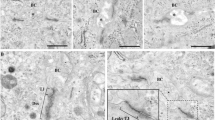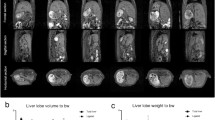Abstract
Objective
To investigate the morphological changes in the liver in patients with organ failure and hyperbilirubinemia and to correlate them to the outcome.
Design
A case series prospective study.
Setting
Intensive care units of two general hospitals.
Patients
Twelve patients in organ failure with predominant hepatic involvement, aged 16 to 69 years (mean 56 years).
Interventions
Liver biopsy was performed on all patients 3–15 days after organ failure. A second biopsy was also performed on all four surviving patients, as well as on 3 patients just before death at a mean time of 16 days (6–32) and 31 days (14–55), respectively, after the first biopsy. The samples were studied by electron microscopy and findings were assessed according to Rappaport's designation.
Measurements and main results
In the first biopsy it was shown that in zone III there was complete degeneration of bile canaliculi and hepatocytes in contrast to zone I. The grade of histological severity for zone III is positively correlated to the bilirubin concentration (p=0.001). In the specimens from the second biopsy, it was shown that numerous, newly formed secondary bile canaliculi per 20 consecutive hepatocytes had developed in zone III in the surviving patients, whereas there was a complete absence of such canaliculi in the patients who died (mean±SD: 9.6±3.2 vs 0).
Conclusions
It appears that the destruction of primary bile canaliculi is a striking anatomical defect in patients with organ failure and impaired bilirubin excretion. The restoration of liver function coincides with adequate formation of new secondary bile canaliculi in zone III, giving credence to the hypothesis that this formation is an important structural change responsible for the improvement in liver function.
Similar content being viewed by others
References
Tugwell P, Williams AO (1977) Jaundice associated with lobar pneumonia. QJM 46:97–118
Zimmerman HJ, Fang M, Utili R, Seeft LB, Hoofnagle J (1979) Jaundice due to bacterial infection. Gastroenterology 77:362–374
Bank JG, Foulis AK, Ledingham I McA, Macsween RNM (1982) Liver function in septic shock. J Clin Pathol 35:1249–1252
Nakatani T, Kobayashi K (1991) Posttraumatic jaundice, its mechanism from a view point of hepatic mitochondrial function. Nippon Geka Gakkai Zasshi 92:441–447
Sarfeh IJ, Balint JA (1978) The clinical significance of hyperbilirubinemia following trauma. J Trauma 18:58–62
Marubayashi S, Dohi K, Ochi K, Kawasaki T (1986) Role of free radicals in ischemic rat liver cell injury: prevention of damage by α-tocopherol administration. Surgery 99:184–192
Nordstrom G, Seeman T, Hasselgren PO (1985) Beneficial effect of allopurinol in liver ischemia. Surgery 97: 679–684
Utili R, Abernathy CO, Zimmerman HJ (1976) Cholestatic effects ofEscherichia coli endotoxin on the isolated perfused rat liver. Gastroenterology 70:248–253
Gourley GR, Chesney PJ, Davis JP, Odell GB (1981) Acute cholestasis in patients with toxic-shock syndrome. Gastroenterology 81:928–931
Lefkowitch JH, Mendez L (1986) Morphologic features of hepatic injury in cardiac disease and shock. J Hepatol 2:313–327
Brough AJ, Bernstein J (1974) Conjugated hyperbilirubinemia in early infancy. Hum Pathol 5:507–516
Ruokonen E, Takala J, Kari A, Alhava E (1991) Septic shock and multiple organ failure. Crit Care Med 19:1146–1151
Rappaport AM (1976) The microcirculatory acinar concept of normal and pathological hepatic structure. Beitr Pathol 157:215–243
Schwartz DB, Bone RC, Balk RA, Szidon JP (1989) Hepatic dysfunction in the adult respiratory distress syndrome. Chest 95:871–875
te-Boekhorst T, Urlus M, Doesburg W, Yap SH, Goris RJ (1988) Etiologic factors of jaundice in severely ill patients. J Hepatol 7:111–117
Lefkowitch JH (1982) Bile ductular cholestasis: an ominous histopathologic sign related to sepsis and “cholangitis lenta”. Hum Pathol 13:19–24
Shoemaker WC, Szanto PB, Fitch LB, Brill NR (1964) Hepatic physiologic and morphologic alterations in shock. J Am Coll Surg 118:828
Alverdy JC, Aoys E, Moss G (1988) Total parenteral nutrition promotes bacterial translocation from the gut. Surgery 104:185–190
Marshall J, Lee C, Meakins JL, Michel RP, Christou NV (1987) Kupffer cell modulation of the systemic immune response. Arch Surg 122:191
Author information
Authors and Affiliations
Rights and permissions
About this article
Cite this article
Douzinas, E.E., Vamvasakis, E., Rigas, K. et al. Bile canaliculi are defective in hepatic involvement of organ failure and recovery of liver function is due to their secondary regeneration. Intensive Care Med 22, 553–558 (1996). https://doi.org/10.1007/BF01708095
Received:
Accepted:
Issue Date:
DOI: https://doi.org/10.1007/BF01708095




